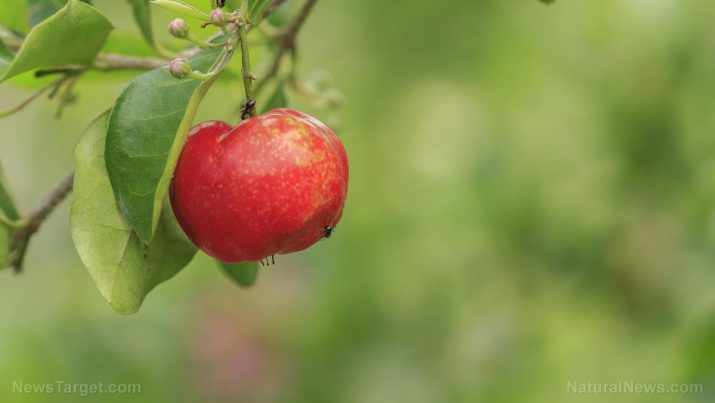
Acerola – sources, health benefits, nutrients, uses and constituents at NaturalPedia.com
Wednesday, June 21, 2017 by Frances Bloomfield
http://www.naturalpedia.com/acerola-sources-health-benefits-nutrients-uses-and-constituents-at-naturalpedia-com.html

Acerola (Malpighia emarginata) is a fruit with many names: “Barbados cherry”, “West Indian cherry”, “Amazon cherry”, “Cereza”, and “Wild Crepemyrtle” are just some of them. Originally from South America, the bushy acerola shrub thrives in warm, tropical climates and does poorly in the cold because of its shallow roots. The cherry-sized fruit is usually bright red or yellow orange and has a pulp with a flavor that has been described as extremely tart and citrus-like, and sweet yet acidic.

List of known nutrients
Of all plant-derived fruits, acerola has the second highest amount of vitamin C after the camu camu; 100 g of acerola contains 1677.67 mg of vitamin C or 1864 percent of the recommended daily intake. Apart from vitamin C, acerola berries are dense with other antioxidants, namely polyphenolic anthocyanidin compounds. These antioxidants are:
- Chrologenic acid
- Cyanidin-3-glycoside
- Ferulic acid
- Kaempferol
- Malvidin
- Pelargonidin
- Quercetin
- Tannins
Other nutrients found in acerola include:
- Copper
- Fiber
- Iron
- Magnesium
- Phosphorus
- Potassium
- Vitamin A
- Vitamin B1
- Vitamin B2
- Vitamin B3
- Vitamin B5
- Vitamin B9
- Zinc
Medicinal uses for acerola
Since it gained widespread use, acerola has been utilized in the treatment of:
- Atherosclerosis
- Cataracts
- Common cold
- Constipation
- Dysentery
- Gum and tooth infections
- Hay fever
- Hyperglycemia
- Intestinal inflammation
- Retinal hemorrhages
- Scurvy
- Thrombosis
- Tooth decay
Low in calories yet dense with vitamin C and polyphenolic anthocyanidin compounds, acerola functions well as a source of natural antioxidants. The exceptionally high content of vitamin C scavenges free radicals from blood, strengthens the immune system, and protects the body from infections and inflammations. Ailments that are usually associated with a vitamin C deficiency, such as the common cold and scurvy, can be prevented by consuming acerola. Vitamin C is also formative in the production of collagen, a structural protein necessary for enhancing the physical performance of athletes and combating the effects of aging.
Due to the abundance of vitamin C, it’s best to take acerola without vitamin C supplements. Taking in too much vitamin C may result in the development of kidney stones, gout, or diarrhea. Moreover, acerola may negatively interact with blood thinners.
Body systems supported by acerola
The abundance of helpful nutrients present in acerola can sustain:
- Digestive system
- Heart
- Immune system
- Vision
Ways to use acerola
Once picked, acerola berries rapidly deteriorate and can start showing noticeable changes within four hours of harvesting. After three or five days, the berries will ferment and become unusable, losing their healthful properties and may even develop mold. Acerola can be frozen to extend the shelf life, however thawing can result in the berries falling apart during the process.
Because of this, acerola berries are often best used to make juices, syrups, and jams. In the Unites States, acerola comes as a powder, a concentrated juice supplement, and a frozen purée. The purée form is perfect for smoothies; coco and vanilla can be used to accent the flavor of an acerola smoothie. It should also be noted that processing acerola berries into juice removes most of the flavonoids.
Where to learn more
- Headache Cures – Things Everyone Should Know
- 5 Ways To Get Over A Cold Fast
- 4 Top Ways to Knock Out a Cold in 1-3 Days
- Five New Super Foods to Enhance Beauty and Well-Being
- 9 Ways to Avoid the Flu This Season
Summary
Acerola is an excellent source of of natural antioxidants, especially vitamin C.
Acerola also has a great amount of vitamin A, a nutrient essential to maintaining vision.
As little as two acerola berries a day can avert retinal hemorrhages and cataract formation.
The antioxidants in acerola can reduce oxidative stress and lower blood sugar levels.
Sources include:
LiveStrong.com
StyleCraze.com
HerbWisdom.com
Nutrition-And-You.com
IncredibleSmoothies.com
Tagged Under: Tags: acerola





